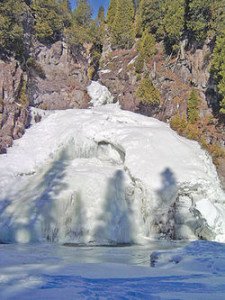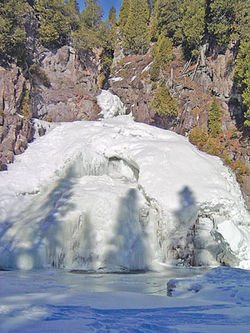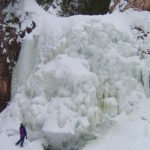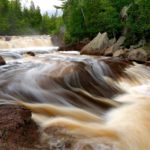It was one of those Minnesota winter mornings when the sky is bluer than any summer sky can be. Though we had hiked along the Caribou River many times, this waterfall trek held a new excitement. It was the first time we had hiked on the river itself. Already heady from seeing four bald eagles along Highway 61, we slid our feet into snowshoes, anxious to venture out onto this frozen winter path.
We soon became aware of the fascinating frozen phenomena the water and cold had concocted. While spectacular ice displays can be seen along the big lake, there are similarly dramatic goings on along her rivers. A stroll up the Caribou in winter is like a combo geology field trip—ice playing the role of rock—and a visit to a gallery of exquisite art glass.

Areas of open water presented a window into the world going on beneath the snow and showed a cross-section of winter days in the ice layers. Some layers had cracked and repositioned, presumably by fluctuations in under-ice flow, causing fault lines and shifting not unlike the geological forces at work in their rock counterparts. Other open water areas were surrounded by ice steps like the terraces carved by farmers on steep hilly land.
The Caribou valley was quiet – as if the river were dozing beneath the blanket of snow. But where the ice had opened, it was obvious that the river was very much awake. The noise of it emanated strangely out of the holes.
The canyon of the Caribou had narrowed and deepened, so we were in shadow as we rounded the curve to the falls. Then, as the canyon opened, and sunlight was unleashed, Caribou Falls rose up in its icy magnificence, glittering like the finest Austrian crystal. The waterfall was broader than when viewed as fluid. But we had a new vantage point, seeing it head-on from the middle of the river rather than being limited by a shore land vista. To the right of the falls, a huge pillar of ice and snow seemed poised to crash to the ground, should the sun warm things a few more degrees.
The bowl formed by the high canyon walls felt unseasonably balmy. The rock was warm to the touch, providing solar heating of the lovely arena. Animal tracks indicated we were not the first to wander up this frozen river. One set of tiny paw prints indicated a route from up above, onto the ice, and then a slide on a belly down an icy slope until diminutive footing was regained.
On the return trek, we marveled at how clear the water was beneath the ice. We peered through one of the ice windows to the still scene below. No motion, just clarity to the gravel beneath. Then, to our surprise, movement caught our eyes and a large fish appeared – pointy nose, shiny back—and then, just as quickly, it passed out of view.
And so the river and its inhabitants are active, even while the human species avoids the winter elements. But if you want to see some wild scenery, exotic by any standard, embrace the winter of the Northern Wilds, and take a hike up the Caribou.
Read More: Barrier Falls of the Devil Track River






